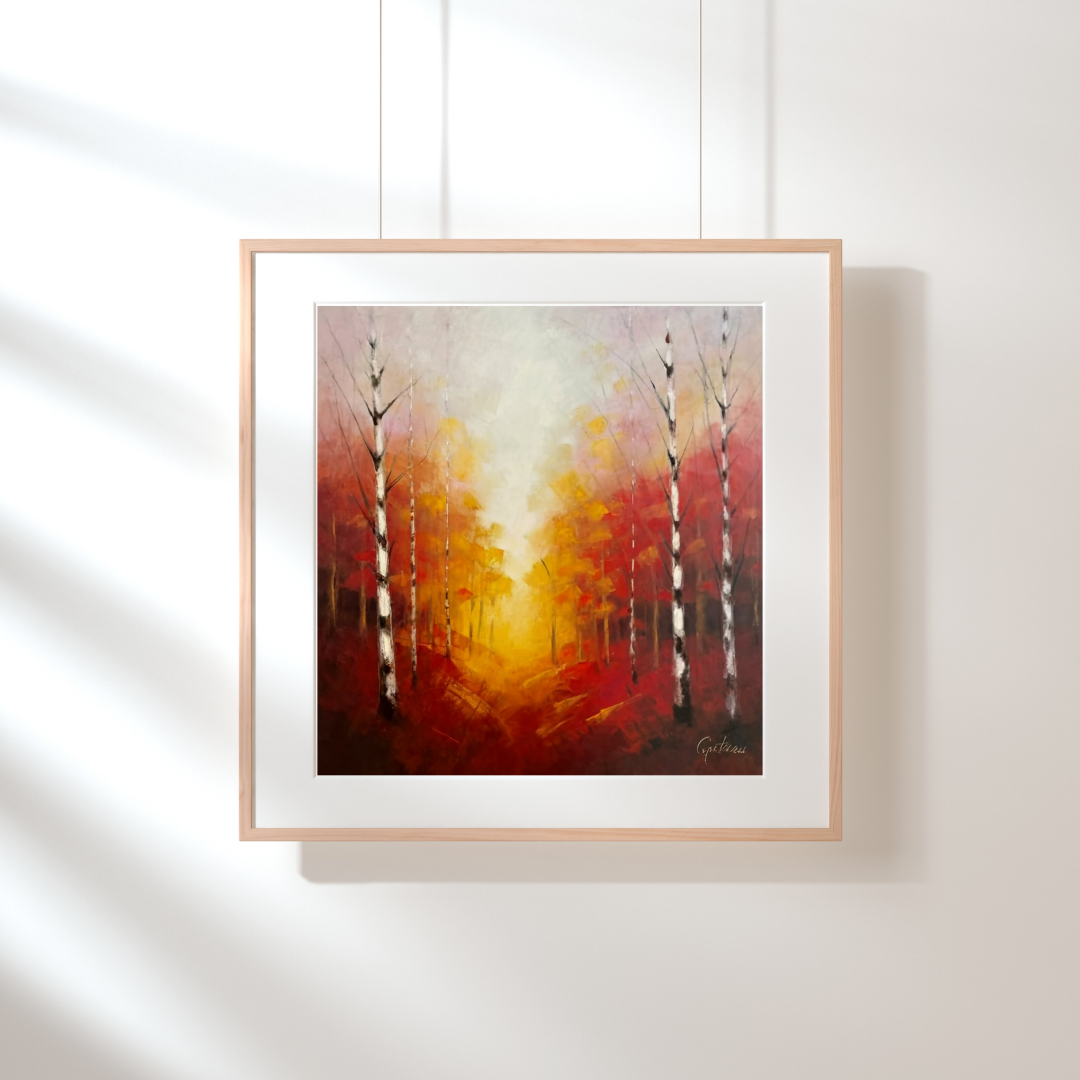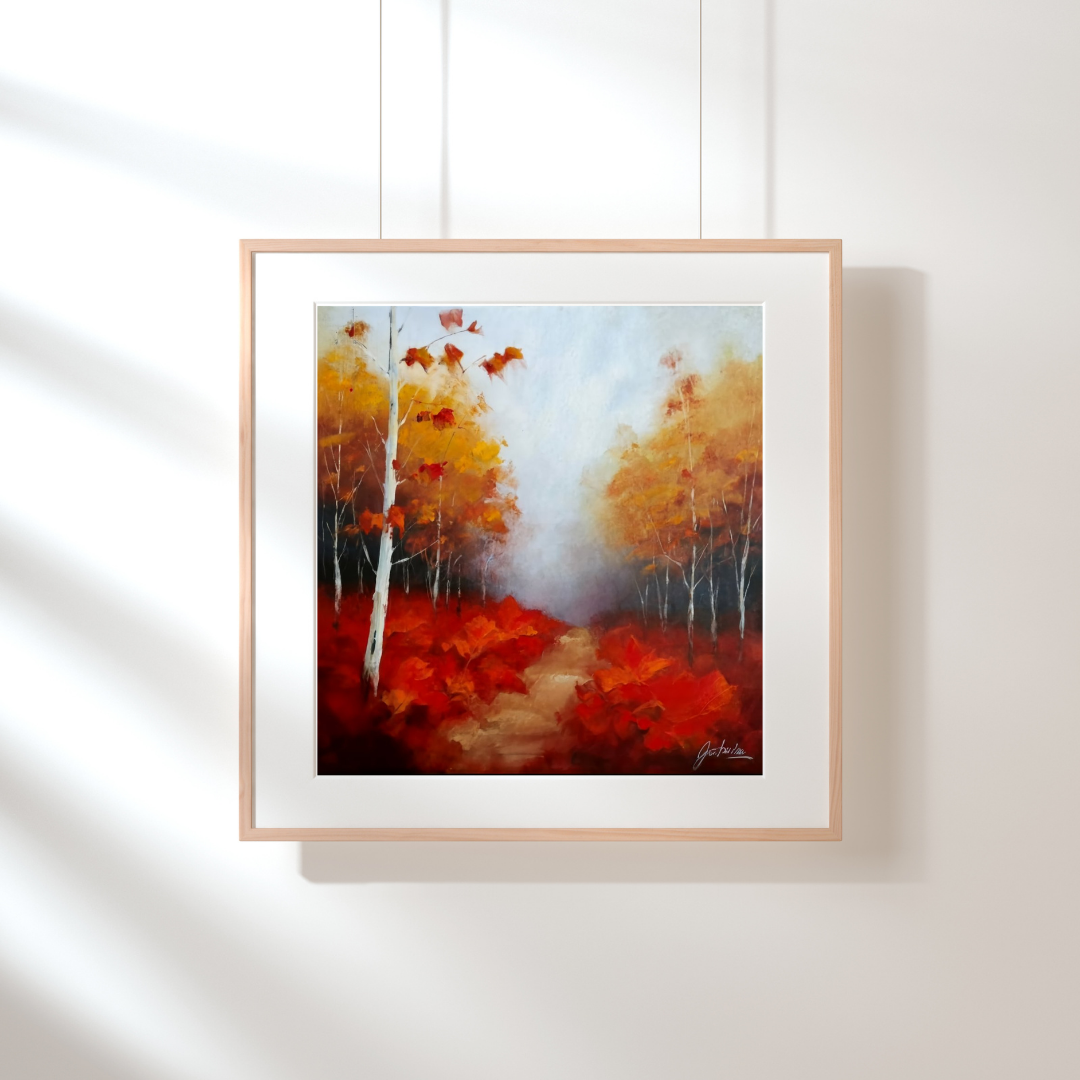Last updated on September 11th, 2024 at 10:20 am
Selling artwork online in Canada isn’t just a nice-to-have anymore – it’s the new frontier.
Gone are the days when you needed a fancy gallery to showcase your work.
Now, with a few clicks and some digital savvy, you can turn your passion into profit from the comfort of your own studio.
But here’s the kicker: most artists are doing it wrong.
They’re treating online sales like an afterthought, missing out on a goldmine of opportunity.
In this guide, I’m going to show you exactly how to tap into the booming online art market in Canada.
We’re talking real, actionable strategies that’ll help you stand out, connect with buyers, and start seeing those sales roll in.
Whether you’re a seasoned pro or just starting out, buckle up.
You’re about to learn how to turn your art into a thriving online business.
Understand the Online Art Market in Canada

Let’s cut to the chase: the Canadian online art market is exploding.
We’re talking about a sector that’s grown by double digits year over year, with no signs of slowing down.
But here’s the thing – most artists are still stuck in the old ways, leaving a massive opportunity for those willing to adapt.
The Current Landscape
- Market Size: The Canadian art market is worth billions, with online sales making up an increasingly significant chunk. The total value of the Canadian art market was estimated at around US$1.3 billion in 2016, with a significant portion of sales occurring through online channels.
- Online sales of the global art and antiques market, which includes Canada, were valued at US$11.8 billion in 2023 and are expected to continue growing.
- Buyer Demographics: Millennials and Gen Z are driving this growth, with 70% of online art buyers under 35.
Why Selling Art Online is a Game-Changer
- Global Reach: You’re no longer limited to local buyers. Your art can be seen and purchased by collectors worldwide.
- Lower Overhead: No need for expensive gallery space or middlemen taking hefty commissions.
- Direct Connection: Build relationships directly with your audience, fostering loyalty and repeat sales.
- Data-Driven Insights: Online platforms provide valuable data on what sells, helping you refine your strategy.
Key Platforms to Consider
- Etsy: Great for handmade and unique pieces, with a built-in audience of art enthusiasts.
- Artsy: Targets high-end collectors and offers a more curated experience.
- Saatchi Art: Provides a balance between accessibility and prestige.
- Your Own Website: Ultimate control and branding, but requires more marketing effort.
Here’s the deal: each platform has its pros and cons.
Your job is to figure out which ones align best with your art style and target audience.
Don’t spread yourself too thin – master one or two platforms before expanding.
Remember, success in the online art world isn’t just about talent.
It’s about understanding the market, positioning yourself effectively, and leveraging the right tools.
In the next sections, we’ll dive deep into how to do just that.
Build Your Online Presence

This is where most artists drop the ball.
Your online presence isn’t just a digital business card – it’s your virtual gallery, your brand, and your sales funnel all rolled into one.
Get this right, and you’ll have collectors knocking down your digital door.
Create a Killer Website
Your website is your home base.
It’s where serious buyers will go to learn more about you and your work.
Here’s how to make it count:
- Keep it clean and professional: Your art should be the star of the show. Use a simple, elegant design that doesn’t distract from your work.
- Make it fast: A slow website kills sales. Optimize your images and choose a reliable hosting provider.
- Showcase your best work: Quality over quantity. Feature your strongest pieces prominently.
- Tell your story: Collectors aren’t just buying art – they’re buying into you as an artist. Share your journey, inspiration, and process.
- Make it easy to buy: Clear pricing, simple checkout process, and multiple payment options are non-negotiable.
Top Tools for Building Your Website:
- Shopify: Great for e-commerce functionality
- WordPress with WooCommerce: More customizable, but requires more technical know-how
- Squarespace: User-friendly with beautiful templates
Dominate Social Media
Social media isn’t just for selfies and cat videos.
It’s a powerful tool for artists to build an audience and drive sales.
Here’s how to crush it:
- Choose your platforms wisely: Focus on visual platforms like Instagram and Pinterest. Facebook can be great for building community.
- Post consistently: Aim for at least 3-5 posts per week. Use a scheduling tool to make this easier.
- Show your process: Behind-the-scenes content builds connection and perceived value.
- Engage authentically: Respond to comments, ask questions, and build relationships with your followers.
- Use hashtags strategically: Research popular art hashtags in your niche and use them to increase visibility.
Pro Tip: Don’t just post finished pieces. Share works in progress, studio shots, and glimpses into your life as an artist. This builds connection and keeps your audience engaged between sales.
Develop Your Artist Brand
Your brand is more than just a logo.
It’s the total experience people have when they interact with you and your art.
Here’s how to craft a brand that sells:
- Define your unique voice: What sets your art apart? What’s your perspective? Articulate this clearly.
- Create a consistent visual identity: Use the same color palette, fonts, and style across all your platforms.
- Craft your artist statement: This is your chance to explain your work and philosophy. Make it compelling.
- Develop a signature style: Whether it’s a particular technique, subject matter, or color palette, having a recognizable style helps you stand out.
- Be authentic: Don’t try to be someone you’re not. Collectors can smell inauthenticity a mile away.
Remember, building a strong online presence takes time and consistent effort.
But here’s the payoff: once you’ve established yourself, sales become much easier.
You’ll have a built-in audience of fans ready to snap up your latest work.
In the next section, we’ll dive into how to price and present your art to maximize sales.
Pricing and Presenting Your Artwork

Alright, let’s talk money.
Pricing your art isn’t just about slapping a number on it and hoping for the best.
It’s a strategic decision that can make or break your online art business.
And presentation?
That’s what turns browsers into buyers.
Let’s break it down.
Pricing Strategies That Work
Pricing art is part science, part art.
Here’s how to get it right:
- Know your costs: Start with materials, time, and overhead. This is your baseline.
- Research the market: What are similar artists charging? Don’t undercut yourself, but be realistic.
- Consider your experience and reputation: As you build a name for yourself, your prices should reflect that.
- Use pricing tiers: Offer works at different price points to cater to various budgets.
- Price consistently: Don’t wildly fluctuate your prices. It erodes trust.
Pro Tip: Start with a price you’re comfortable with, then increase gradually as you gain traction. It’s easier to raise prices than to lower them.
Photography That Sells
In the online world, your photos are your storefront.
Nail this, and you’re halfway to a sale.
Here’s how:
- Invest in good equipment: You don’t need a pro setup, but a decent camera and lighting make a huge difference.
- Shoot in natural light: It shows off your work best. Avoid harsh shadows or glare.
- Capture details: Include close-ups that show texture and brushwork.
- Show scale: Use props or models to give a sense of size.
- Be consistent: Use the same background and style for all your pieces.
Top Tools for Art Photography:
- Adobe Lightroom: For editing and organizing your photos
- Snapseed: A great mobile option for quick edits
- A good tripod: Essential for sharp, consistent shots
Write Descriptions That Convert
Your artwork description is your sales pitch.
Make it count:
- Tell a story: What inspired the piece? What does it represent?
- Be specific: Include size, medium, and any unique features.
- Use emotive language: Help the buyer imagine owning the piece.
- Highlight uniqueness: What makes this piece special?
- Include social proof: Mention if it’s been featured in exhibitions or publications.
Here’s an example:

“Autumn Whispers” – 24″x36″ Acrylic on Canvas
Inspired by a misty morning walk in the Gatineau Hills, this piece captures the fleeting beauty of fall in Canada. The vibrant reds and golds contrast with cool, ethereal mists, inviting the viewer to step into a moment of tranquil beauty. This painting was featured in the “Emerging Artists of Ottawa” exhibition and has garnered praise for its innovative use of texture to create depth.
Bring the essence of Canadian autumn into your home with this statement piece that will be a conversation starter for years to come.
Remember, your goal is to not just describe the art, but to sell the experience of owning it.
Marketing and Promotion Strategies
Alright, you’ve got your online presence set up, your art is priced and presented beautifully.
Now what?
It’s time to get eyeballs on your work.
Let’s look into marketing strategies that’ll have collectors clamoring for your art.
Email Marketing: Your Secret Weapon
Email might seem old school, but it’s still the most effective marketing channel out there.
Here’s how to use it:
- Build your list: Offer something valuable (like a free print or behind-the-scenes content) in exchange for email addresses.
- Segment your audience: Group subscribers based on their interests or past purchases.
- Provide value: Don’t just sell. Share your process, inspirations, and exclusive content.
- Use storytelling: Take subscribers on a journey with each email.
- Time your sends: Test different days and times to see what works best for your audience.
Pro Tip: Use a tool like MailChimp or ConvertKit to automate your email marketing. Set up a welcome series for new subscribers to introduce them to your work.
Collaborations and Partnerships
Want to fast-track your growth? Collaborate.
Here’s how:
- Partner with complementary businesses: Think interior designers, home decor stores, or even local cafes.
- Guest blog: Write articles for art blogs or magazines to increase your visibility.
- Collaborate with other artists: Create joint pieces or collections.
- Participate in online art fairs: Many have shifted to virtual formats, opening up new opportunities.
- Engage with art communities: Be active in online forums and groups where art enthusiasts gather.
Paid Advertising: Scaling Your Reach
When you’re ready to invest in growth, paid ads can be a game-changer.
Here’s what to focus on:
- Facebook and Instagram Ads: Great for targeting specific demographics and interests.
- Google Ads: Capture people actively searching for art like yours.
- Retargeting: Show ads to people who’ve visited your website but didn’t purchase.
- Influencer Partnerships: Collaborate with art influencers or interior design accounts.
- Pinterest Ads: Ideal for visual products like art.
Top Tools for Digital Marketing:
- Canva: Create stunning graphics for social media and ads
- Buffer: Schedule and manage your social media posts
- Google Analytics: Track your website traffic and conversions
Content Marketing: Positioning Yourself as an Expert
Creating valuable content does two things: it attracts potential buyers and establishes you as an authority.
Here’s how to do it:
- Start a blog: Share insights about your techniques, the art world, or collecting tips.
- Create video content: Show your process, give studio tours, or offer art tips.
- Host webinars or live Q&As: Engage directly with your audience.
- Write an ebook: Offer a deeper dive into your art philosophy or techniques.
- Contribute to art publications: Get your name out there in established channels.
Remember, the key to effective marketing is consistency.
It’s not about one big push – it’s about showing up day after day, building relationships, and providing value.
Do this right, and you’ll create a loyal following that’s eager to support your work.
Shipping and Fulfillment

Alright, you’ve made the sale. Congratulations!
But your job isn’t done yet.
How you handle shipping and fulfillment can make or break your reputation as an online artist.
Let’s make sure your masterpieces arrive safely and on time.
Package Artwork Like a Pro
First things first: protect that art.
Here’s how to package like a boss:
- Invest in quality materials: Acid-free tissue paper, bubble wrap, and sturdy boxes are your best friends.
- Layer your protection: Wrap in tissue, then bubble wrap, then a final layer of cardboard.
- Use corner protectors: These little guys can save your frames from disaster.
- Include a handling label: Mark the package as “Fragile” and “Handle with Care.”
- Consider climate: If shipping to extreme climates, use additional insulation.
Pro Tip: Create an unboxing experience. Include a thank you note, care instructions, and maybe even a small gift like a postcard of another piece. It’s these touches that turn buyers into lifelong fans.
Shipping Options: Balancing Cost and Speed
Choosing the right shipping method is crucial.
Here’s what to consider:
- Canada Post: Reliable and cost-effective for domestic shipping.
- Fedex or UPS: Better for international or high-value shipments.
- Flat rate vs. calculated shipping: Decide if you’ll charge a flat rate or calculate based on distance and size.
- Insurance: Always insure valuable pieces. It’s worth the extra cost.
- Tracking: Provide tracking numbers to buyers for peace of mind.
Handling Returns and Exchanges
Nobody wants returns, but they happen.
Here’s how to handle them gracefully:
- Have a clear policy: Spell out your return and exchange terms on your website.
- Be reasonable: A 14-30 day return window is standard.
- Decide who pays for return shipping: This can depend on the reason for the return.
- Inspect returned items carefully: Document any damage before processing refunds.
- Learn from returns: Use feedback to improve your product descriptions or packaging.
Key Point: A smooth return process can actually increase customer trust and lead to future sales.
Read also: Best Practices for Returns and Refunds in Canadian eCommerce
Fulfillment Services: When to Outsource
As your business grows, you might consider outsourcing fulfillment.
Here’s when it makes sense:
- High volume: If you’re shipping more than 10-20 items per day.
- International focus: Fulfillment services can navigate customs more easily.
- Limited space: When your art is taking over your living space.
- Time constraints: If packing and shipping is eating into your creation time.
- Scaling up: When you’re ready to focus on growing your business rather than day-to-day operations.
Remember, your art doesn’t stop being your responsibility once it’s sold.
How it’s packaged, shipped, and received is part of the total customer experience.
Get this right, and you’ll not only avoid headaches but also create loyal customers who rave about your service.
Legal and Financial Considerations

This is where a lot of artists get tripped up.
Ignoring the legal and financial side of selling art online isn’t just risky – it can tank your whole operation.
But don’t worry, I’m going to break it down for you in simple terms.
Understand Canadian Tax Implications
Taxes might not be sexy, but they’re crucial.
Here’s what you need to know:
- GST/HST Registration: If you make over $30,000 in a year, you need to register for and collect GST/HST.
- Income Tax: Your art sales are income. Keep track of everything and be prepared to pay taxes on your profits.
- Deductions: Track your expenses – materials, studio rent, marketing costs. These can offset your taxable income.
- PST: Depending on your province, you may need to collect Provincial Sales Tax.
- Keep Records: Save all receipts and maintain detailed sales records. Your future self will thank you come tax time.
Pro Tip: Consider using accounting software like QuickBooks or Wave to keep track of your finances. It’ll save you headaches when it’s time to file taxes.
Copyright and Intellectual Property Protection
Your art is your asset. Protect it.
Here’s how:
- Automatic Copyright: In Canada, you automatically own the copyright to your original works. But registration provides additional benefits.
- Use Watermarks: For online images, use subtle watermarks to deter theft.
- Licensing: Consider licensing your art for different uses. It can be a great additional income stream.
- Clear Agreements: When selling, be clear about what rights the buyer is getting. Are they buying just the physical piece, or rights to reproduce it?
- Take Action on Infringement: If someone uses your art without permission, don’t hesitate to send a cease and desist letter.
Setting Up Payment Systems
Getting paid should be easy for you and your customers.
Here’s how to set it up right:
- Choose Your Platforms: PayPal, Stripe, and Square are popular options for artists.
- Offer Multiple Payment Methods: Credit cards, e-transfers, and even cryptocurrency if you’re tech-savvy.
- Consider Installment Plans: For higher-priced pieces, offering payment plans can make your art more accessible.
- Be Clear About Fees: Decide whether you’ll absorb transaction fees or pass them on to the customer.
- Secure Your Transactions: Ensure your website is SSL certified to protect customer data.
Business Structure: Sole Proprietorship vs. Corporation
As your art business grows, you’ll need to decide on a business structure.
Here are the basics:
Sole Proprietorship:
- Easiest to set up
- You and the business are the same entity
- Personal liability for business debts
Corporation:
- More complex to set up
- Separate legal entity from you
- Limited liability protection
- Potential tax advantages
Key Point: Consult with an accountant or lawyer to determine the best structure for your situation.
Contracts and Terms of Service
Protect yourself with clear agreements:
- Sales Contracts: For significant sales, use a contract that outlines all terms.
- Website Terms of Service: Clearly state your policies on returns, shipping, and usage rights.
- Commission Agreements: If you take commissions, have a standard agreement that covers timelines, revisions, and payment terms.
- Gallery Consignment Agreements: If working with galleries, ensure you have clear contracts.
- Licensing Agreements: If licensing your art, use detailed agreements to protect your rights.
Remember, the legal and financial aspects of your art business are just as important as the creative side.
Get these right, and you’ll have a solid foundation for growth and success.
Ignore them, and you’re setting yourself up for potential disasters down the road.
In the next section, we’ll wrap things up and give you a roadmap for getting started with selling artwork online in Canada.
Final Thoughts
Alright, let’s bring it all home.
We’ve covered a lot of ground in this guide to selling artwork online in Canada.
From building your online presence to mastering the art of shipping, you now have the blueprint for success.
But here’s the thing: knowledge without action is useless.
So what’s your next move?
Key Takeaways:
- Your online presence is your new gallery: Invest time in creating a stunning website and engaging social media profiles.
- Price strategically: Your art has value. Price it accordingly and don’t be afraid to increase prices as you gain recognition.
- Marketing is key: Use email, collaborations, and targeted advertising to get your art in front of the right people.
- Protect yourself legally and financially: Don’t ignore the business side. Set up proper structures and keep meticulous records.
- Deliver an exceptional experience: From purchase to delivery, make every interaction with your customers memorable.
Your Action Plan:
- Start today: Choose one aspect of your online presence to improve this week.
- Set clear goals: Where do you want your art business to be in 6 months? A year? Five years?
- Build your systems: Set up your website, email list, and financial tracking.
- Create consistently: Keep producing art and sharing your journey.
- Network and collaborate: Connect with other artists, galleries, and potential partners.
Remember, selling artwork online in Canada is not just about transactions.
It’s about building relationships, creating value, and sharing your unique vision with the world.
The online art market in Canada is booming, and there’s plenty of room for artists who are willing to put in the work.
So, are you ready to turn your passion into a thriving online business?
The canvas is yours. It’s time to make your mark.
FAQ Section
Q: Do I need to register my art business in Canada?
A: It depends on your income and business structure. If you’re making over $30,000 annually, you’ll need to register for GST/HST. Consider consulting with an accountant for personalized advice.
Q: How do I price my artwork for online sales?
A: Consider your costs, time invested, market rates for similar work, and your experience level. Start with a price you’re comfortable with and adjust based on demand and your growing reputation.
Q: What’s the best platform for selling art online in Canada?
A: There’s no one-size-fits-all answer. Etsy is great for beginners, while platforms like Artsy cater to higher-end markets. Your own website gives you the most control. Consider starting with one platform and expanding as you grow.
Q: How do I protect my artwork from being copied online?
A: Use watermarks on images, clearly state your copyright, and consider registering your most valuable works. Be prepared to enforce your rights if infringement occurs.
Q: What should I do if a piece is damaged during shipping?
A: First, ensure you have proper insurance. If damage occurs, document it thoroughly, file a claim with the shipping company, and work with the customer to find a satisfactory resolution.
Q: How often should I be posting on social media to promote my art?
A: Aim for consistency rather than frequency. Posting 3-5 times a week is a good starting point. Focus on quality content that engages your audience and showcases your work.
Q: Can I sell my art internationally from Canada?
A: Absolutely! Just be aware of international shipping costs, customs regulations, and potential tax implications. Consider starting with North American sales before expanding globally.
Read also:
 cPanel Web HostingAffordable Canadian cPanel hosting, user-friendly and reliable.
cPanel Web HostingAffordable Canadian cPanel hosting, user-friendly and reliable. Reseller HostingStart your own hosting business with flexible reseller hosting plans.
Reseller HostingStart your own hosting business with flexible reseller hosting plans. Affiliate ProgramJoin our affiliate program and earn commissions by referring customers.
Affiliate ProgramJoin our affiliate program and earn commissions by referring customers. DomainsFind the perfect domain for your business or personal site with ease.
DomainsFind the perfect domain for your business or personal site with ease. Domain TransferTransfer your domain to us and keep your website running without interruption.
Domain TransferTransfer your domain to us and keep your website running without interruption. WHOIS LookupQuickly find who owns a domain with our easy WHOIS search tool.
WHOIS LookupQuickly find who owns a domain with our easy WHOIS search tool. VPS HostingReliable VPS hosting crafted for performance and peace of mind.
VPS HostingReliable VPS hosting crafted for performance and peace of mind.
